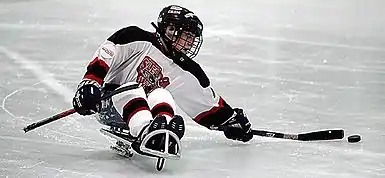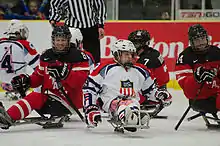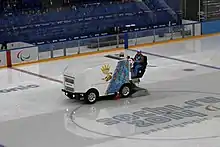Sledge hockey
Sledge hockey (also known as Para ice hockey, or sled hockey in American English) is an adaptation of ice hockey designed for players who have a physical disability. Invented in the early 1960s at a rehabilitation centre in Stockholm, Sweden, and played under similar rules to standard ice hockey, players are seated on sleds and use special hockey sticks with metal "teeth" on the tips of their handles to navigate the ice.


Via its division World Para Ice Hockey, the International Paralympic Committee (IPC) acts as the international sanctioning body for the sport by means of its World Para Ice Hockey division. Para ice hockey has been played in the Winter Paralympics since 1994, and has been one of the most popular events.[1]
History
Two men from Sweden designed the sledge in the 1960s because they wanted to continue to play hockey despite their physical disabilities. Their design included two skate blades on a metal frame that allowed the puck to pass underneath. They completed the ensemble by including two round poles with bike handles for sticks. Although there are many restrictions to the measurements and weight of the sleds used in the Paralympic Games, the basic design of modern sleds remains true to the original 1960's simple sleds for kids. These sleds were then made to be used hockey.
Despite the initial lack of interest and awareness in the few years that followed, competition between sledge hockey teams started up in 1971 that included five teams in Europe. In 1981, Great Britain established their first sledge hockey team, and that was shortly followed by Canada in 1982. It was not until 1990 that the United States developed their first ice sledge hockey team. Sled hockey continued to expand when Estonia and Japan developed their teams in 1993. Sledge hockey was introduced to the Winter Paralympics in 1994, with Sweden claiming the first gold medal. Since 2010, sledge hockey has been a mixed-gender event.[2]
On November 30, 2016, as part of an effort to improve and unify the marketing of its self-sanctioned sports outside of the Paralympic Games, and citing that the word "sledge" had differing meanings between languages, the International Paralympic Committee announced that it would henceforth refer to sledge hockey as Para ice hockey (with its sanctioning sub-division consequently renamed World Para Ice Hockey).[3]
Equipment

The sticks have a blade curved at one end in a manner similar to regular ice hockey, and generally six to eight metal teeth at the opposite end of the blade for maneuvering and propulsion. Movement is achieved by using the metal teeth as a means to grip the ice and push oneself forward. The metal teeth cannot be too pointy nor protrude farther than 1 cm beyond the stick, to prevent damage to the ice or injury of other players. Other equipment includes a helmet with facemask, shoulder and elbow pads, shin guards, and hockey gloves. Pants and footwear are at the discretion of both the player's comfort and need. Goaltenders wear the standard mask, chest and arm protector, blocker pad and catching glove, plus a leg pad if they so desire and a stick with teeth on both the paddle as well as the knob of the stick. Additionally, goalies may make modifications to their equipment: a common mod is to attach the plastic outsoles of track spikes onto the outer part of their gloves to aid in lateral mobility.

Rules
Essentially all of the standard rules of ice hockey apply to sledge hockey. The differences are those necessitated by the ice sled and the athlete. The first set of international rules was created in 1990 and were drafted from Canadian rules. The only penalty unique to sledge hockey is Teeing—the act of charging an opponent using any part of the front radius of the sled. Players with limited mobility in their arms are permitted the use of an able-bodied assistant. Pushers must wear a team jersey and safety equipment, and cannot exceed the speed of the average player on the ice nor can they enter the "house" (the area extending from the goal crease to the end-zone faceoff dots, extended to the top of the faceoff circles) while in the defensive zone.
Games are divided into three 15-minute periods, followed by overtime (and if still tied after the overtime period, a shootout) if there is a tie at the end of regulation
See also
- Para ice hockey at the Winter Paralympics
- World Para Ice Hockey Championships
- IPC Ice Sledge Hockey European Championships
- British Sledge Hockey Association, the governing body for the sport in the U.K.
- USA Warriors, a Para ice hockey team consisting of combat-wounded U.S. soldiers
- Power hockey, electric wheelchair hockey
- Ice sledge racing, a sport that uses the same sticks and sledges for racing instead of hockey
References
- Canadian National Men's Sledge Hockey Team. (2004). Canadian success in sledge hockey. Retrieved January 27, 2006, from
- Canadian Paralympic Committee. (2006). Torino 2006. Retrieved January 16, 2006, from
- Hockey Alberta. (2004). Sledge hockey tournaments. Retrieved January 16, 2006, from
- International Paralympic Committee. (2006). Ice sledge hockey. Retrieved January 16, 2006, from
- International Paralympic Ice Hockey Rulebook. (2005). International Paralympic Committee. Retrieved January 17, 2006, from
- International Wheelchair Basketball Federation. (2003). Promoting excellence and developing opportunities. Retrieved January 16, 2006, from
- It's The Real Deal. (2005). Paralympic schools program. Retrieved January 16, 2006, from
- Paralympic Sports Association. (2004). Sledge hockey. Retrieved January 17, 2006, from
- Salt Lake 2002 Paralympics. (2002). Historical records. Retrieved January 16, 2006, from
- Spokes n’ Motion (2006). Retrieved January 16, 2006, from
- CanWin Sports(2006). Retrieved November 20, 2006, from
- Paralympics GB (2009). Retrieved December 23, 2009, from
- http://usawarriorshockey.org/?p=432
- http://video.capitals.nhl.com/videocenter/console?id=186113
Citations
- "Paralympics unhappy with CTV's plan". Toronto. Archived from the original on March 17, 2010.
- "Sledge hockey teams can add women for 2010 Games". CTVOlympics.ca. 2009-04-03. Retrieved 2010-02-22.
- "Rebranding of sledge hockey causing concerns". Canadian Press. April 18, 2017. Retrieved April 7, 2019.
External links
| Look up sledge hockey, ice sledge hockey, sled hockey, or para ice hockey in Wiktionary, the free dictionary. |
| Wikimedia Commons has media related to Ice sledge hockey. |